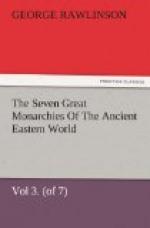The elevated plateau which stretches from the foot of those two mountain regions to the south and east is, for the most part, a flat sandy desert, incapable of sustaining more than a sparse and scanty population. The northern and western portions are, however, less arid than the east and south, being watered to some distance by the streams that descend from Zagros and Elburz, and deriving fertility also from the spring rains. Some of the rivers which flow from Zagros on this side are large and strong. One, the Kizil-Uzen, reaches the Caspian. Another, the Zenderud, fertilizes a large district near Isfahan. A third, the Bendamir, flows by Persepolis and terminates in a sheet of water of some size—lake Bakhtigan. A tract thus intervenes between the mountain regions and the desert which, though it cannot be called fertile, is fairly productive, and can support a large settled population. This forms the chief portion of the region which the ancients called Media, as being the country inhabited by the race on whose history we are about to enter.
Media, however, included, besides this, another tract of considerable size and importance. At the north-western angle of the region above described, in the corner whence the two great chains branch out to the south and to the east, is a tract composed almost entirely of mountains, which the Greeks called Atropatene, and which is now known as Azerbijan. This district lies further to the north than the rest of Media, being in the same parallels with the lower part of the Caspian Sea. It comprises the entire basin of Lake Urumiyeh, together with the country intervening between that basin and the high mountain chain which curves round the south-western corner of the Caspian, It is a region generally somewhat sterile, but containing a certain quantity of very, fertile territory, more particularly in the Urumiyeh basin, and towards the mouth of the river Araxes.
The boundaries of Media are given somewhat differently by different writers, and no doubt they actually varied at different periods; but the variations were not great, and the natural limits, on three sides at any rate, may be laid down with tolerable precision. Towards the north the boundary was at first the mountain chain closing in on that side the Urumiyeh basin, after which it seems to have been held that the true limit was the Araxes, to its entrance on the low country, and then the mountain chain west and south of the Caspian. Westward, the line of demarcation may be best regarded as, towards the south, running along the centre of the Zagros region; and, above this, as formed by that continuation of the Zagros chain which separates the Urumiyeh from the Van basin. Eastward, the boundary was marked by the spur from the Elburz, across which lay the pass known as the Pylse Caspise, and below this by the great salt desert, whose western limit is nearly in the same longitude. Towards the south there was no marked line or natural boundary;




